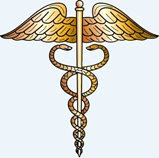Travel With Confidence This Summer…
HAVE YOU HAD YOUR SHOTS?
Kyler S. Knight, M.D.
Certified, American Board of Internal Medicine
Centuries ago, when settlers came to our shores from “across the pond,” they brought with them germs and bacteria that were alien to the natives who inhabited this country. The results were predictable: outbreaks of infectious diseases, like measles and influenza, that were often fatal to the  Indians who came into contact with them for the first time. Today, when a person can travel to virtually anyplace in the world within a day and a half, the problem of encountering or transmitting unfamiliar organisms and diseases remains a threat. We can travel faster than the incubation period for many diseases. Thanks in part to the fact that Hollywood has dramatized the specter of spreading a deadly virus or bacteria by chance encounter with a traveler, many people are worried about protecting their health when travelling outside the United States for the first time.
Indians who came into contact with them for the first time. Today, when a person can travel to virtually anyplace in the world within a day and a half, the problem of encountering or transmitting unfamiliar organisms and diseases remains a threat. We can travel faster than the incubation period for many diseases. Thanks in part to the fact that Hollywood has dramatized the specter of spreading a deadly virus or bacteria by chance encounter with a traveler, many people are worried about protecting their health when travelling outside the United States for the first time.
“It is true that travelers to undeveloped or tropical countries have been known to contract some relatively rare or exotic diseases,” explained Internist Kyler S. Knight, M.D. “The disease may not surface for months  after they return to this country and, when it does, it may be difficult to diagnose because it is so uncommon. Now that we live in such a global community, it is increasingly important for people who travel to research the destinations they plan to visit and to be alert for any specific health warnings. Then, it is up to them to get the necessary vaccines or immunizations and to keep good records on where they have been -- and when – in the event they should become ill after they return. Fortunately, this is not terribly difficult to do.”
after they return to this country and, when it does, it may be difficult to diagnose because it is so uncommon. Now that we live in such a global community, it is increasingly important for people who travel to research the destinations they plan to visit and to be alert for any specific health warnings. Then, it is up to them to get the necessary vaccines or immunizations and to keep good records on where they have been -- and when – in the event they should become ill after they return. Fortunately, this is not terribly difficult to do.”
There are also preventive measures travelers can take to stay healthy and to minimize their risk of “catching” infectious diseases. Since many serious diseases have been eradicated around the world thanks to persistent immunization efforts, preparing for an international trip today is not nearly as complicated as it would have been in the mid-1900’s. The types of preventive measures and vaccinations depend on the destination, the time of year in which the travel will take place, and how long the visitor intends to stay.
 Obviously, preparing for a backpacking excursion to South America would call for a totally different medical intervention than would a train trip through the United Kingdom. This is not to say that travelers do not become ill while visiting other “civilized” countries, but the likelihood of encountering the rare, and sometimes life-threatening kinds of diseases is generally much less, and special immunizations are therefore not indicated or required.
Obviously, preparing for a backpacking excursion to South America would call for a totally different medical intervention than would a train trip through the United Kingdom. This is not to say that travelers do not become ill while visiting other “civilized” countries, but the likelihood of encountering the rare, and sometimes life-threatening kinds of diseases is generally much less, and special immunizations are therefore not indicated or required.
“Many people tend to forget, however, that some of our routine immunizations need to be updated periodically,” advised Dr. Knight. “including tetanus, influenza and those for what people consider childhood illnesses – mumps and measles. For some destinations, travelers should consider having the hepatitis A shot. People who plan to visit the Pacific, Africa, Southeast Asia or the Amazon Region of South America are likely to need more aggressive preventive measures that may include inoculation or prophylaxis against typhoid, yellow fever or malaria, hepatitis B, cholera, or other bacteria or viruses.”

Dr. Knight points out that any time we disrupt our normal patterns of eating and sleeping, we become more susceptible or vulnerable to disease or infection. International travel, requiring long flights and time changes, can be particularly exhausting for some people. In those cases, he says, it is important to get rested up as soon as possible. Common sense tells us that getting off an intercontinental flight and getting immediately behind the wheel of a car for a long drive in unfamiliar territory is literally an accident just waiting to happen. He suggests that there are many things travelers can do to stay healthy on the road.
“Planning for a trip or vacation should involve a lot more than just booking reservations for hotels and transportation,” Knight recommended, “especially if you have any known medical problems. See your dentist and get that aching tooth fixed. Arrange for refills of any prescription medications so that you’ll have enough even if your trip is unexpectedly extended. If you have any serious or chronic health problems, it’s not a bad idea to take along key information about your medical history, including medication dosages and allergies, as well as anything else that might be helpful to medical personnel in an emergency. If you wear glasses or contacts, be sure to take along an extra pair or two, and don’t pack them all in the same place. If you rely on over-the-counter medications – for headaches or diarrhea especially -- that might be difficult to obtain where you are going, take a supply of those, too.”
Be sensible about what you eat and drink on foreign soil. Contaminated food and water/ice are the major sources of stomach or intestinal illness  while traveling, according to the Centers for Disease Control and Prevention. “Travelers’ Diarrhea” (TD) can turn an otherwise sensational vacation into one spent within racing distance to the bathroom. The ailment may not be life threatening, but after a day or two of abdominal cramps and discomfort, some tourists have certainly wished they were dead. Any uncooked food could be contaminated, especially in areas where sanitation is not a local priority. Be especially wary of salads, fruits and raw vegetables, dairy products, improperly prepared meats, and shellfish. It’s best to rely on bottled water for brushing your teeth, and that or canned beverages for drinking. Even if you don’t ‘drink the water’ that’s what the local ice is made from, and it can make you just as sick.
while traveling, according to the Centers for Disease Control and Prevention. “Travelers’ Diarrhea” (TD) can turn an otherwise sensational vacation into one spent within racing distance to the bathroom. The ailment may not be life threatening, but after a day or two of abdominal cramps and discomfort, some tourists have certainly wished they were dead. Any uncooked food could be contaminated, especially in areas where sanitation is not a local priority. Be especially wary of salads, fruits and raw vegetables, dairy products, improperly prepared meats, and shellfish. It’s best to rely on bottled water for brushing your teeth, and that or canned beverages for drinking. Even if you don’t ‘drink the water’ that’s what the local ice is made from, and it can make you just as sick.
“Take the trip in your mind first,” suggests Dr. Knight. “Visualize where you’ll be and anticipate what emergencies you might encounter – and plan for them. If you’ll be spending a lot of time outside, be sure to take along  plenty of sunscreen and insect repellant if you’re visiting the warmer regions. A compact first aid kit is another useful travelling companion, and be sure to include all the minor remedies you are used to at home.”
plenty of sunscreen and insect repellant if you’re visiting the warmer regions. A compact first aid kit is another useful travelling companion, and be sure to include all the minor remedies you are used to at home.”
“If youngsters will be traveling with you, arrange for their immunizations to be updated as far in advance as possible, and pack a supply of their medications, too. If your trip will be to an undeveloped country or to a tropical location, schedule an appointment for a consultation about any immunizations or vaccinations that are required for entry into those places at least six weeks before your planned departure. This will allow the immunity to develop before you leave and will help you be alert to other health risks you might encounter at your destination. Whether you will be traveling on business or for pleasure,” the doctor said, “the last thing you’ll need in an unfamiliar environment is to be sick or in pain, and careful planning can make all the difference – wherever you are in the world.”
Dr. Knight is a designated provider of the Yellow Fever Vaccine.


 About 70 percent of people undergoing chemotherapy experience severe stomach upset. But taking
About 70 percent of people undergoing chemotherapy experience severe stomach upset. But taking 


 Indians who came into contact with them for the first time. Today, when a person can travel to virtually anyplace in the world within a day and a half, the problem of encountering or transmitting unfamiliar organisms and diseases remains a threat. We can travel faster than the incubation period for many diseases. Thanks in part to the fact that Hollywood has dramatized the specter of spreading a deadly virus or bacteria by chance encounter with a traveler, many people are worried about protecting their health when travelling outside the United States for the first time.
Indians who came into contact with them for the first time. Today, when a person can travel to virtually anyplace in the world within a day and a half, the problem of encountering or transmitting unfamiliar organisms and diseases remains a threat. We can travel faster than the incubation period for many diseases. Thanks in part to the fact that Hollywood has dramatized the specter of spreading a deadly virus or bacteria by chance encounter with a traveler, many people are worried about protecting their health when travelling outside the United States for the first time.  after they return to this country and, when it does, it may be difficult to diagnose because it is so uncommon. Now that we live in such a global community, it is increasingly important for people who travel to research the destinations they plan to visit and to be alert for any specific health warnings. Then, it is up to them to get the necessary vaccines or immunizations and to keep good records on where they have been -- and when – in the event they should become ill after they return. Fortunately, this is not terribly difficult to do.”
after they return to this country and, when it does, it may be difficult to diagnose because it is so uncommon. Now that we live in such a global community, it is increasingly important for people who travel to research the destinations they plan to visit and to be alert for any specific health warnings. Then, it is up to them to get the necessary vaccines or immunizations and to keep good records on where they have been -- and when – in the event they should become ill after they return. Fortunately, this is not terribly difficult to do.”  Obviously, preparing for a backpacking excursion to South America would call for a totally different medical intervention than would a train trip through the United Kingdom. This is not to say that travelers do not become ill while visiting other “civilized” countries, but the likelihood of encountering the rare, and sometimes life-threatening kinds of diseases is generally much less, and special immunizations are therefore not indicated or required.
Obviously, preparing for a backpacking excursion to South America would call for a totally different medical intervention than would a train trip through the United Kingdom. This is not to say that travelers do not become ill while visiting other “civilized” countries, but the likelihood of encountering the rare, and sometimes life-threatening kinds of diseases is generally much less, and special immunizations are therefore not indicated or required. 
 while traveling, according to the Centers for Disease Control and Prevention. “Travelers’ Diarrhea” (TD) can turn an otherwise sensational vacation into one spent within racing distance to the bathroom. The ailment may not be life threatening, but after a day or two of abdominal cramps and discomfort, some tourists have certainly wished they were dead. Any uncooked food could be contaminated, especially in areas where sanitation is not a local priority. Be especially wary of salads, fruits and raw vegetables, dairy products, improperly prepared meats, and shellfish. It’s best to rely on bottled water for brushing your teeth, and that or canned beverages for drinking. Even if you don’t ‘drink the water’ that’s what the local ice is made from, and it can make you just as sick.
while traveling, according to the Centers for Disease Control and Prevention. “Travelers’ Diarrhea” (TD) can turn an otherwise sensational vacation into one spent within racing distance to the bathroom. The ailment may not be life threatening, but after a day or two of abdominal cramps and discomfort, some tourists have certainly wished they were dead. Any uncooked food could be contaminated, especially in areas where sanitation is not a local priority. Be especially wary of salads, fruits and raw vegetables, dairy products, improperly prepared meats, and shellfish. It’s best to rely on bottled water for brushing your teeth, and that or canned beverages for drinking. Even if you don’t ‘drink the water’ that’s what the local ice is made from, and it can make you just as sick.  plenty of sunscreen and insect repellant if you’re visiting the warmer regions. A compact first aid kit is another useful travelling companion, and be sure to include all the minor remedies you are used to at home.”
plenty of sunscreen and insect repellant if you’re visiting the warmer regions. A compact first aid kit is another useful travelling companion, and be sure to include all the minor remedies you are used to at home.” 
 Bisphenol-A (BPA), the endocrine disrupting chemical found in baby bottles and canned food, has been getting a lot of bad press over the past year. It's really no surprise given the growing list of studies linking it to health impacts ranging from cognitive problems and early puberty to increased fat cell production and miscarriage.
Bisphenol-A (BPA), the endocrine disrupting chemical found in baby bottles and canned food, has been getting a lot of bad press over the past year. It's really no surprise given the growing list of studies linking it to health impacts ranging from cognitive problems and early puberty to increased fat cell production and miscarriage.























